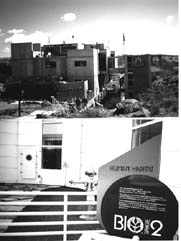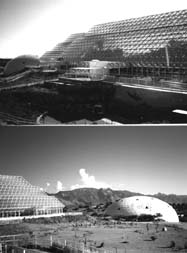|
But by 1993, Arcosanti was just a historical site. It seemed to me that the dream of harmony with human technology (architecture) and the tranquil flow of time there had gone out of date. I drove next to Biosphere 2 to have a look at a technological ecology this time, instead of a primitive ecology. Biosphere 2, the second Earth, was created on September 26, 1991 as the second planet populated by living creatures. It was almost exactly two years later that I visited--three weeks before the eight Biospherians returned to the Earth. According to John ALLEN, the director of the project, the purpose of Biosphere 2 is to study the mechanisms that allow the natural environment, the earth, to regulate itself. To try and control the entire planet through human technology is indeed a big project. In Arcosanti, a calm life unfolds within a water-based natural cooling system as bells are made and natural foods are eaten. In contrast, Biospherians make their life in a five-story habitat designed for humans. Cooking is done in a kitchen equipped with a refrigerator and microwave oven, and communication with the outside world is maintained by fax and videophones. The inner environment of the dome, completely cut off from the outside world, is monitored by sensors and controlled by a cybernetic system. Is controlling the ecology the only way for us to survive? It's natural to use technology in the way that the Biosphere project does, as if the sole purpose was anthropocentric life. Yet, this project definitely has a blind faith in technology; there is a total lack of doubt there.
|

|
